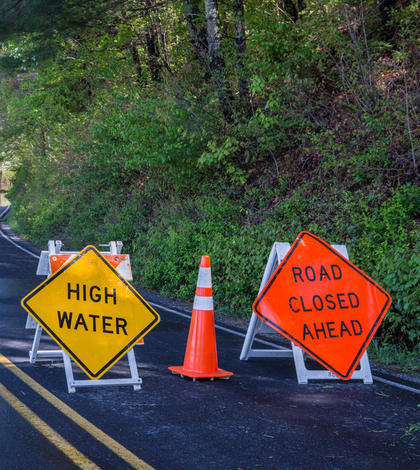If the recent, catastrophic fires in both northern and southern California aren’t enough, Mother Nature may continue to wreak havoc with rains that are predicted to roll across the state this week. Although none of the forecasts are predicting excessive amounts of rain, the devastation and charred hillsides from the Camp and Woolsey Fires may lead to flash flooding, debris flows and mud slides.
Flooding can occur in fire damaged areas when the rain hits the ash-covered ground. The thick ash becomes a barrier preventing the water from soaking into a hillside and it instead creates a somewhat oily mess. This helps propel the water downhill. If there is enough water the downhill water can become a flood and begin to gain speed creating a debris flow. If the rain water is able to seep into the ground where there is less ash covering the ground it can dislodge the charred ground and cause a mudflow. Either scenario can become dangerous in a matter of minutes; heed the advice of officials and first responders if you are told to evacuate.
Communities downslope of burn areas are especially at an increased risk of flash flooding, mudflows, and debris flows. The California Department of Water Resources (DWR) has indicated that with 7,421 fires and more than 1.6 million acres burned, 2018 has been California’s most destructive fire year on record. Wildfires change the landscape, destroying the root structure of trees and vegetation and creating top soil that could repel water instead of absorbing it.
DWR’s 2018 Flood After Fire brochure indicates that whereas an average debris flow is between 10 to 15 feet, the height of the average American is 5 feet, 7 inches. Similarly, the height of an average two-story house is 25 feet versus debris flows which have reached 35 feet. Whereas mudflows are primarily made up of water and soil, debris flows carry vegetation, trees, large rocks/boulders and even automobile.
Debris flows can knock homes off their foundations; mudflows do not. But mudflows can seep into a home and destroy the home’s interior. As a debris flow loses steam – and most of the actual debris – it can become a mudflow.
Unbeknownst to most people, debris flows and mudflows can occur for up to five years after a wildfire. Thunderstorms that develop over burn areas can cause flash flooding and debris flows almost as fast as the National Weather Service radar can detect the rainfall and debris flows can move at 35 mph and travel miles from where they start. It is critical that if you live in a burn area or downhill from a burn area, they you remain vigilant, have a preparedness plan for your family and pets, and move quickly when told to evacuate.
DWR’s Flood After Fire brochure provides some specific information for both before and during floods and debris flows plus an extensive list of other helpful resources at: https://water.ca.gov/-/media/DWR-Website/Web-Pages/What-We-Do/Flood-Preparedness/Files/2018-Flood-After-Fire-brochure.pdf?la=en&hash=CAE02E917C2E71AE12DC987D99381EBD2121A93A.
 California Water News Daily Your Source For Water News in California
California Water News Daily Your Source For Water News in California


